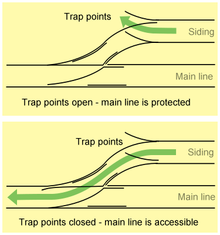
Catch points and trap points are types of points which act as railway safety devices. Both work by guiding railway carriages and trucks from a dangerous route onto a separate, safer track. Catch points are used to derail vehicles which are out of control (known as runaways) on steep slopes. Trap points are used to protect main railway lines from unauthorised vehicles moving onto them from sidings or branch lines. Either of these track arrangements may lead the vehicles into a sand drag or safety siding, track arrangements which are used to safely stop them after they have left the main tracks.
A derail is another device used for the same purposes as catch and trap points.


Trap points are found at the exit from a siding or where a secondary track joins a main line. A facing turnout is used to prevent any unauthorised movement that may otherwise obstruct the main line.[1] The trap points also prevent any damage that may be done by a vehicle passing over points not set for traffic joining the main line.[2] In the United Kingdom, the use of trap points at siding exits is required by government legislation.[2]
An unauthorised movement may be due to a runaway wagon, or may be a train passing a signal at danger. When a signal controlling passage onto a main line is set to "danger", the trap points are set to derail any vehicle passing that signal. Interlocking is used to make sure that the signal cannot be set to allow passage onto the main line until the trap points have been aligned to ensure this movement can take place.
Trap points should preferably be positioned to ensure that any unauthorised vehicle is stopped a safe distance from the main line. However, due to space limitations, it is not always possible to guarantee this.
If the lines are track circuited and a wagon or train using the catchpoint could foul an adjacent line, then a track circuit interrupter will be fitted to one of the run-off rails. When a train runs off it will break the track circuit and set main line signals to 'danger'.
There are several different ways of constructing trap points:[2]
The type of trap points to be used depends on factors such as the gradient of the siding, and whether locomotives enter the siding.[2]

Catch points are used where track follows a rising gradient. They are used to derail (or "catch") any unauthorised vehicles travelling down the gradient.[1] This may simply be a vehicle that has accidentally been allowed to run away down the slope, or could be a wagon that has decoupled from its train.[2] In either case, the runaway vehicle could collide with a train farther down the slope.
Catch points may consist of a full turnout or a single switch blade. In some cases, on a track that is only traversed by uphill traffic, trailing point blades are held in a position to derail any vehicle travelling downhill. However, any traffic travelling in the correct (uphill) direction can pass over the turnout safely, pushing the switch blades into the appropriate position. Once the wheels have passed, the catch points are forced back into the derailing position by springs.[2] In these cases, a lever may be provided to temporarily override the catch points and allow safe passage down the gradient in certain controlled circumstances.
The use of catch points became widespread in the United Kingdom after the Abergele rail disaster (1868), where runaway wagons containing paraffin oil (kerosene) collided with an express train. Catch points continued to be used in the UK until the mid-20th century. At this time, continuous automatic brakes, which automatically stop any vehicles separated from their train, were widely adopted, making catch points largely obsolete.[citation needed]
Sometimes a track is located between two other tracks that are converging, and there is nowhere for a catchpoint to divert a train to. In such cases, a pair of single catchpoints of left and right hand may be provided to derail the overrunning train without directing it to either side. The two blades of an ordinary turnout may also be operated separately for the same purpose.
Examples would be the north and south ends of platforms 1 and 2 at Hornsby in New South Wales[citation needed].
|
"Sand drag" redirects here. For off-road drag racing, see Drag racing. |

In some cases, catch points and trap points direct vehicles into a sand drag or safety siding, also sometimes called an arrestor bed. This may be a siding simply leading to a mound of sand, gravel or other granular material, or a siding where the rails are within sand-filled troughs.[1] This method of stopping a vehicle travelling at speed is preferred over a buffer stop as there is less shock to the vehicle involved.[2]
A cheap and simple alternative to catch points or a derail is a chock block, which is a piece of timber that can be positioned and locked over one of the rails at the end of a siding to protect the main line from runaways. In order for the siding to be used the chock block must be removed.

Because catch points are rarely needed, it is not always clear whether they will in fact derail a runaway train effectively and as safely as possible. For example, use of catch points to derail a train that had passed a signal at danger at London Paddington station in June 2016 resulted in the empty train, a Class 165, hitting and severely damaging an overhead line electrification stanchion, causing all services to and from the station to be halted for hours.[3]
In 2010, in snowy conditions, at Carrbridge, a Class 66 passed a red signal as well as catch points, leading to the train going down the embankment, injuring the two crew on board.[4]